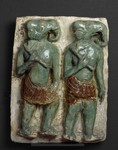Это цитата сообщения ГЛАГОЛЪ Оригинальное сообщение
Pegu, c. 1479.University of Oxford - Ashmolean Museum
Drinking vessel: Date: ca. 4th century BCE – 2nd century CE Medium: Gold Uranium, Thorium—4Helium dating, Asia.
Siren:Date: c. 5th Century BCE Medium: Gold Size: 6 1/8” h, Asia.
 [показать]
[показать]
Bracket with a woman riding a fantastic creature, made in Begram, Afghanistan, 1st-2nd century
 [показать]
[показать]
A polychrome painted wood Architectural Strut Kerala, South India, circa 1800 depicting a mythical vyala, with bulging eyes, gaping mouth and elaborate mane, in rearing position with an apsaras riding on its back 156 cm.
 [показать]
[показать] [720x]
[720x] [показать]
[показать]The name Nergal, Nirgal, or Nirgali refers to a deity in Babylon with the main seat of his cult at Cuthah represented by the mound of Tell-Ibrahim. Nergal is mentioned in the Hebrew bible as the deity of the city of Cuth (Cuthah): “And the men of Babylon made Succoth-benoth, and the men of Cuth made Nergal” (2 Kings, 17:30). According to the rabbins, his emblem was a cock and Nergal means a “dunghill cock”. He is the son of Enlil and Ninlil.
 [570x685]
[570x685] [показать]
[показать] [показать]
[показать]The Babylonians believed that the demoness Lamashtu was responsible for still births and cot-deaths. A woman would have worn this quartzite stone amulet (now broken) during pregnancy and labour so that the fierce demons on it, and the incantation on the back, would scare Lamashtu away
 [показать]
[показать]A Lamassu (Sumerian: dlamma; Akkadian: lamassu), is a protective deity, often depicted with a bull or lion’s body, eagle’s wings, and human’s head. In some writings, it is portrayed to represent a female deity. A less frequently used name is shedu (Sumerian: dalad; Akkadian, šēdu; Hebrew: שד) which refers to the male counterpart of a lamassu.
 [показать]
[показать]MUSHUSSU - Babylon dragon of Chaos.
 [720x]
[720x] [показать]
[показать]Assyrian, 883-859. The Brooklyn Museum
 [показать]
[показать] [показать]
[показать] [показать]
[показать] [показать]
[показать] [показать]
[показать] [показать]
[показать] [показать]
[показать] [показать]
[показать] [показать]
[показать] [показать]
[показать]Mushussu (also known as Mushhushshu or Sirrush) is the Dragon of Babylon and one of two animals depicted on the Ishtar Gate.
 [720x507]
[720x507] [показать]
[показать] [показать]
[показать]Лилит.
 [показать]
[показать]На веревке аннунаки привели монстра к Эа.Нечем тут хвастаться,опять урод получился,не способный к продолжению рода,а оно,пожалуй,и к лучшему.
 [показать]
[показать]
 [720x]
[720x]
Megiddo. An applique (12th Century BCE) showing a winged sphinx .
Кормящая мама-сфинкс)) В руках настольная лампа))
 [720x]
[720x]
Стамбульский археологический музей
 [720x]
[720x]
 [720x]
[720x]
 [588x1024]
[588x1024]
Berner Münster, Bern


